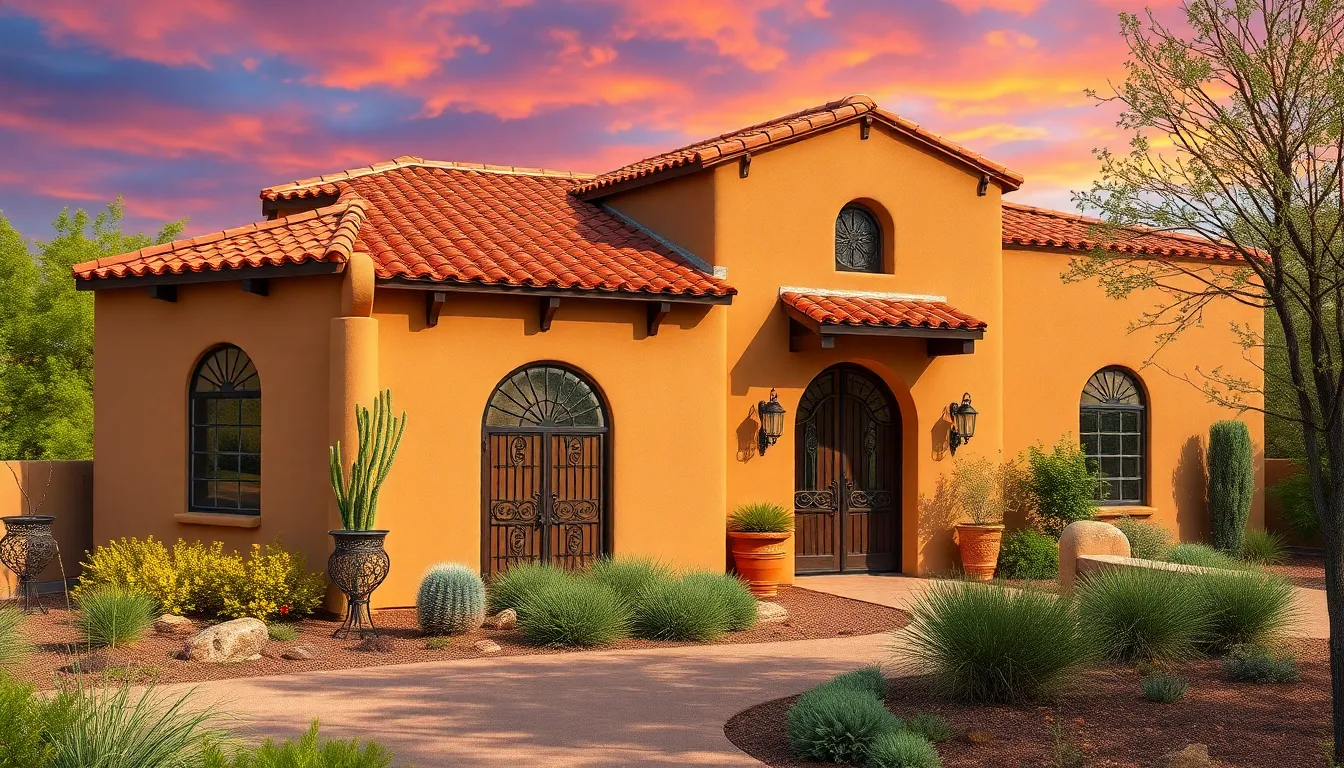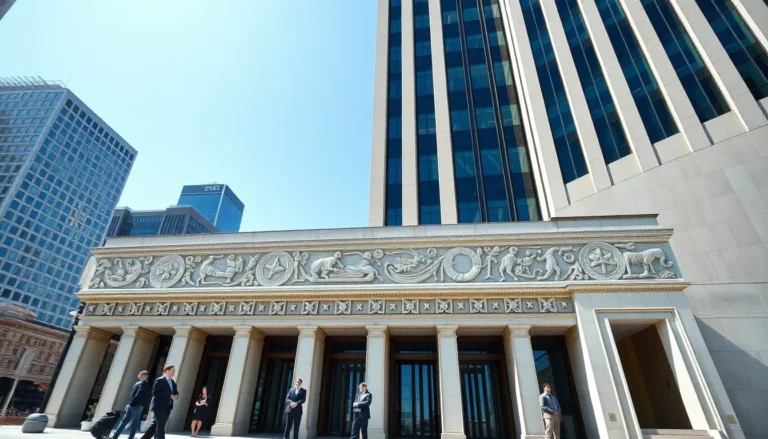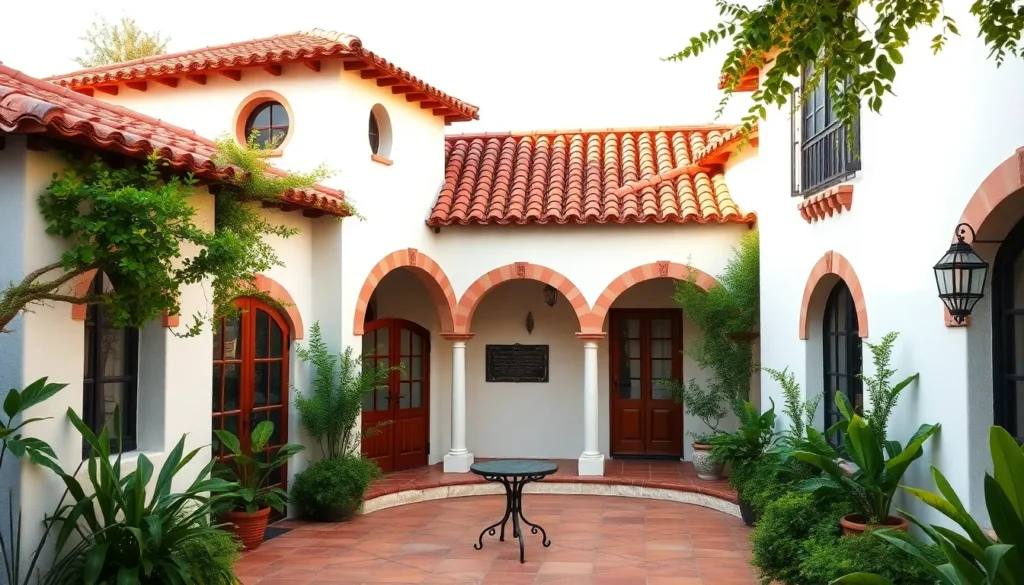Table of Contents
ToggleSpanish house architecture is like a warm embrace on a sunny afternoon—inviting, vibrant, and full of character. With its stunning tile work, arched doorways, and sun-soaked patios, this style transports anyone to the sun-drenched streets of Spain without the need for a passport. Whether it’s a cozy pueblo or a grand hacienda, these homes tell stories of culture, history, and a love for outdoor living.
Overview of Spanish House Architecture
Spanish house architecture showcases a blend of historical and cultural influences, creating distinctive and inviting homes. Key characteristics include vibrant tile work, which often features intricate patterns and vivid colors. Arched doorways add elegance and timeless appeal, while sun-soaked patios provide a seamless transition between indoor and outdoor spaces.
Colors play a significant role in this architectural style, with warm earth tones like terracotta and beige dominating facades. These hues reflect the sun and landscape, enhancing the charm of the structures. In addition, wrought iron details often appear in railings and window grilles, contributing to the ornate nature of Spanish architecture.
Roofs typically feature red clay tiles, which not only add to the aesthetic but also provide effective insulation against heat. Courtyards, an integral element, serve as tranquil retreats, often adorned with lush gardens and fountains. Such spaces encourage a strong connection to nature and outdoor living.
The design of Spanish houses incorporates both functional and decorative elements. For instance, thick walls help keep interiors cool, a practical adaptation to the warm climate. Decorative accents, like colorful ceramics and hand-painted murals, lend character and reflect local craftsmanship.
Reflecting regional variations, styles range from the quaint charm of pueblo homes to the grandeur of haciendas. Each architectural style tells a story, reflecting the cultural richness and historical significance of Spain. Spanish house architecture embodies warmth, inviting residents and visitors to enjoy the beauty and history encapsulated in each structure.
Key Characteristics of Spanish House Architecture

Spanish house architecture showcases unique materials and features that embody its cultural richness.
Use of Adobe and Stucco
Adobe, a natural building material made from clay and straw, plays a pivotal role in Spanish architecture. Homes often use adobe to create thick walls that provide essential insulation against heat. Stucco, a material made from cement or lime, adds an elegant finish to these structures. Walls covered in stucco display earthy hues, seamlessly blending with the natural surroundings. This choice of materials not only enhances aesthetic appeal but also reflects the region’s climate, promoting energy efficiency. Buildings constructed with adobe and stucco captivate with their rustic charm and durability, making them timeless choices.
Tile Roofs and Wrought Iron
Red clay tile roofs create a distinctive profile for Spanish houses, offering visual appeal and practical benefits. These tiles facilitate rainwater drainage while also keeping the interior cool. The roofs often feature vibrant colors that complement the earthy tones of the walls. Wrought iron accents enrich the architecture, appearing in railings, gates, and window grills. These details add an ornate touch and enhance security while showcasing craftsmanship. Together, tile roofs and wrought iron elements emphasize the character of Spanish architectural design, creating a harmonious blend of functionality and beauty.
Regional Variations in Spanish House Architecture
Spanish house architecture showcases diverse regional styles influenced by history and geography. Each area offers unique design elements that reflect its cultural identity.
Andalusian Styles
Andalusian architecture emphasizes whitewashed walls and intricate tilework. Homes often feature shaded courtyards adorned with lush greenery, providing a cool retreat from the sun. Arched windows and wrought iron balconies typify the style, adding elegance to the façade. The use of Islamic design elements, like muqarnas and decorative tiles, highlights the region’s rich Moorish heritage. Additionally, terracotta roofing complements the bright colors used in the interiors, enhancing the overall aesthetic appeal.
Catalan Influences
Catalan architecture incorporates a blend of Gothic and Modernist styles, seen in the use of bold colors and organic shapes. Characteristic features include the use of brick and stone, creating a sturdy appearance. Buildings often showcase elaborate facades with decorative motifs. Curved lines and asymmetrical shapes differentiate Catalan homes from other Spanish styles, adding a whimsical touch. Catenary arches frequently appear in design, reflecting innovative architectural techniques developed during the Modernist movement. These influences create a distinctive charm, representing the vibrant culture of Catalonia.
Modern Adaptations of Spanish House Architecture
Modern adaptations of Spanish house architecture incorporate contemporary materials and design principles while retaining traditional charm. Architects often blend stucco and adobe with sustainable building practices, improving energy efficiency. Designers enhance outdoor living spaces with expanded patios and open floor plans that encourage interaction with nature.
Innovation frequently showcases the use of glass elements in windows and doors, allowing natural light to flood interiors. With a focus on minimalism, sleek lines complement the ornate features of classic Spanish architecture, bridging the gap between old and new. Natural stone and wood details add warmth and texture, enhancing overall aesthetics.
Technology increasingly integrates smart home features for improved safety and convenience. Automated systems manage lighting, climate control, and security, allowing homeowners to maintain the cozy atmosphere of traditional Spanish homes with modern efficiency. Additionally, landscape architecture often includes drought-resistant plants, reflecting environmental concerns prevalent in today’s designs.
The emphasis on indoor-outdoor living continues to grow, with courtyards becoming focal points for relaxing and entertaining. Expansive sliding doors blur boundaries between inside and outside, fostering connectivity with the surrounding environment. Local artisans remain vital, as they preserve traditional craftsmanship in tile work and wrought iron designs, providing authenticity in modern adaptations.
Regional influences still shape these contemporary designs, ensuring that homes resonate with the spirit of their locations. Coastal adaptations might incorporate ocean-friendly materials and colors. Desert adaptations often focus on passive cooling strategies, integrating classic techniques with modern efficiencies. By balancing innovation with time-honored elements, modern Spanish house architecture captures the essence of its heritage while evolving to meet the needs of today.
Spanish house architecture stands as a testament to a rich cultural heritage that marries beauty with functionality. Its vibrant colors and intricate designs invite admiration while fostering a deep connection to nature and community. The seamless blend of traditional elements with modern innovations ensures that these homes remain relevant and appealing in today’s world.
As they evolve, Spanish houses continue to reflect the diverse influences of their regions, celebrating both history and contemporary living. This architectural style not only enhances the aesthetic landscape but also enriches the lives of those who inhabit them, making each structure a cherished part of the community.







